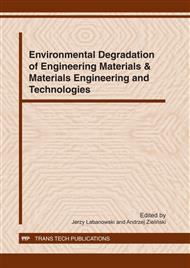[1]
G. Gimenez, F. Goby: Cavitation and inhomeneities in underwater acoustics. Springer-Verlag, Berlin. (1981) 101-108.
Google Scholar
[2]
A. Balitskii, J. Chmiel, L Dorobczynski: Analysis of electrochemical oscillations in vibration cavitation conditions. Physicochemical Mechanics of Materials 1-2011, pp.24-29.
Google Scholar
[3]
C.T. Kwok, F.T. Cheng, H.C. Man: Synergistic effect of cavitation erosion and corrosion of various engineering alloys in 3. 5% NaCl solution. Materials Sciences and Engineering A290 (2000) 143-145.
DOI: 10.1016/s0921-5093(00)00899-6
Google Scholar
[4]
V.M.A. Devanathan, Z. Stachurski: The mechanism of hydrogen evolution on iron in acid solutions by determination of permeation rates. J. Electrochem. Soc. 111 (1964) 619-623.
DOI: 10.1149/1.2426195
Google Scholar
[5]
J. Chmiel: Advances in the research into the phenomena of corrosion-cavitation and hydrogen-cavitation wear. Polish Journal of Environmental Studies 18 (2009) 33-38.
Google Scholar
[6]
B. Baranowski: Diffusion in Elastic Media with Stress Fields in Adv. in Thermodyn., Flow, Diffusion and Rate Processes. S. Sieniutycz and P. Salomon [eds] Taylor and Francis, NY. 1992, 168-199.
Google Scholar
[7]
E. Lunarska, O. Chernyayeva, L. Spivak: Hydrogen-straining effects in Al. J. of Alloys and Compounds 404-406C (2005) 269-272.
DOI: 10.1016/j.jallcom.2005.02.094
Google Scholar
[8]
J. O'M. Bockris, P.K. Subramanyan: Hydrogen embrittlement and hydrogen traps. J. Electrochem. Soc. 118 (1971) 1114-1121.
DOI: 10.1149/1.2408257
Google Scholar
[9]
G.M. Pressouyre, I.M. Bernstein: A quantitative analysis of hydrogen tramping. Metall. Trans. 9A (1978) 1571-1576.
Google Scholar
[10]
E. Lunarska, K. Nikiforow, E. Sitko: Stress corrosion cracking of bainite 0. 3C-1Cr-1Mn-1Si-1Ni type steel in acid rain simulated solution. Werkstoffe und Korrosion. 54 (2004) 373-380.
DOI: 10.1002/maco.200303747
Google Scholar
[11]
W.S. Gorsky: Theorie der elastischen nachwirkung in ungeordneten mischkristallen (elastische nachwirkung zweiter art. ). Phys. Z. der Sowjetunion 8 (1935) 451-471.
Google Scholar
[12]
F.A. Lewis: Uphill hydrogen diffusion effects: nature and manifestations. in Progress in hydrogen treatment of materials. Goltsov V.A. [ed. ], Donetsk-Coral.
Google Scholar
[13]
J. Chmiel: N509 2925 35 Report. Grant of Polish Ministry of Science and Higher Education (2010).
Google Scholar


